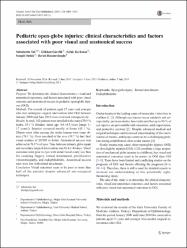Pediatric open-globe injuries: clinical characteristics and factors associated with poor visual and anatomical success
Abstract
We determine the clinical characteristics, visual and anatomical outcomes, and factors associated with poor visual outcome and anatomical success in pediatric open-globe injuries (OGI). The records of patients aged 17 years and younger who had undergone surgical intervention after OGI between January 2000 and June 2010 were reviewed retrospectively. In total, 182 patients were enrolled in the study (70.9 % males, 29.1 % females; mean age: 8.6 +/- 4.5 years [range 1-17 years]). Injuries occurred mostly at home (45.1 %). Objects most often causing the ocular trauma were sharp objects (74.1 %). Over one-third of the eyes (39.7 %) had final visual acuities of 20/200 or better. Anatomical success was achieved in 76.9 % of eyes. Time between primary globe repair and secondary surgical intervention was 61.4 +/- 144 days. Visual outcomes were poor in eyes with initial visual acuity less than for counting fingers, retinal detachment, proliferative vitreoretinopathy, and endophthalmitis. Anatomical success rates were low with retinal detachment. Visual outcomes seem to be poor in more than half of the patients despite advanced microsurgical techniques.


















